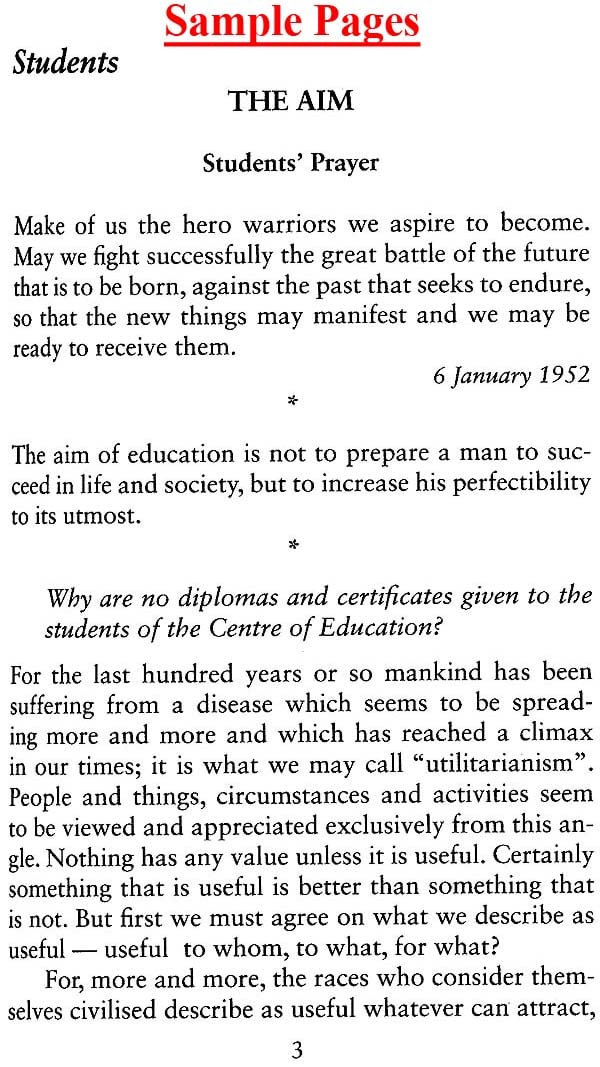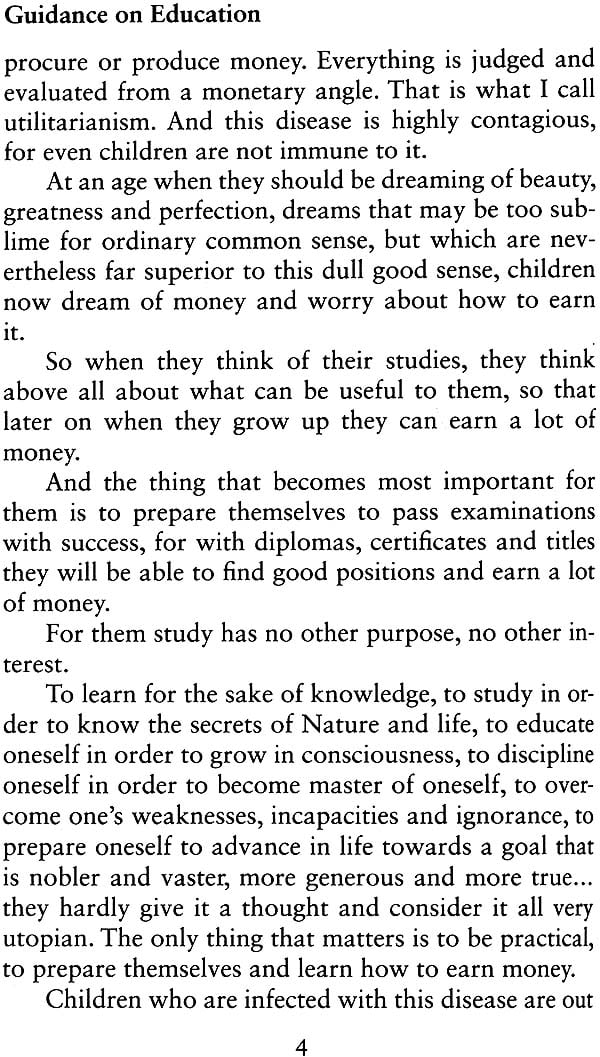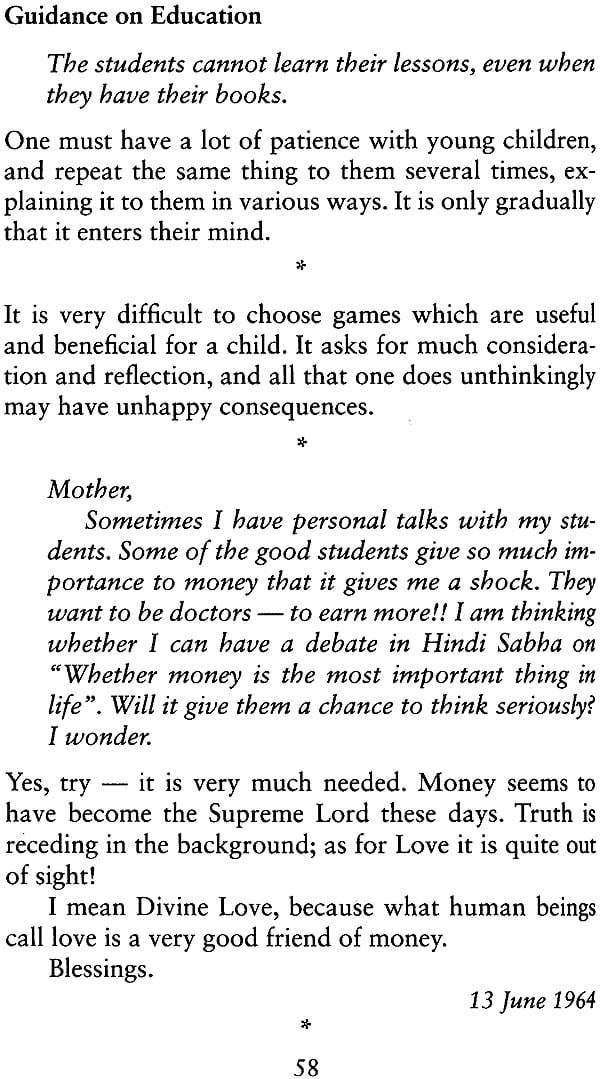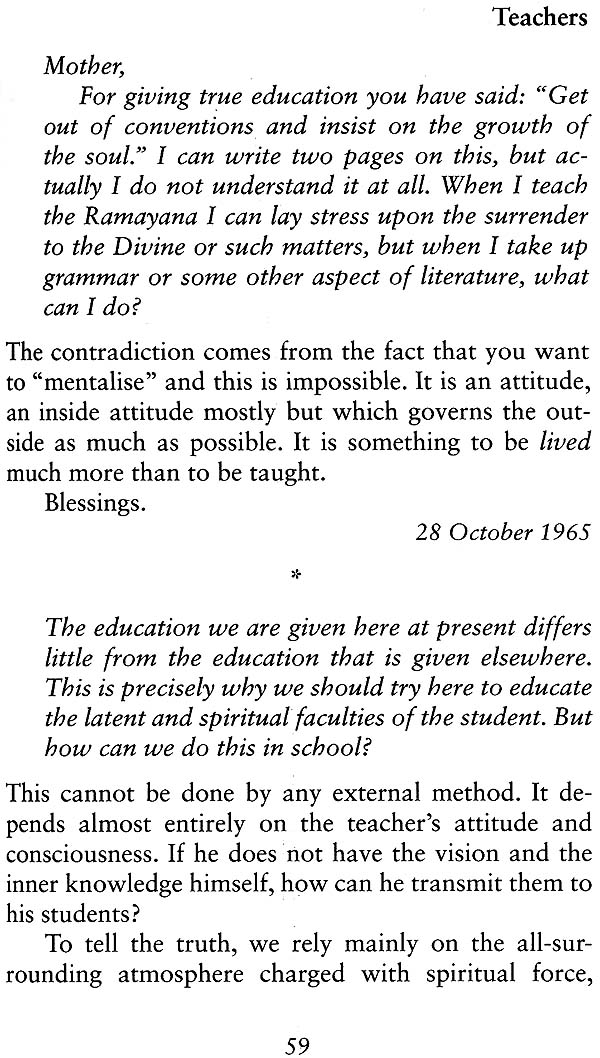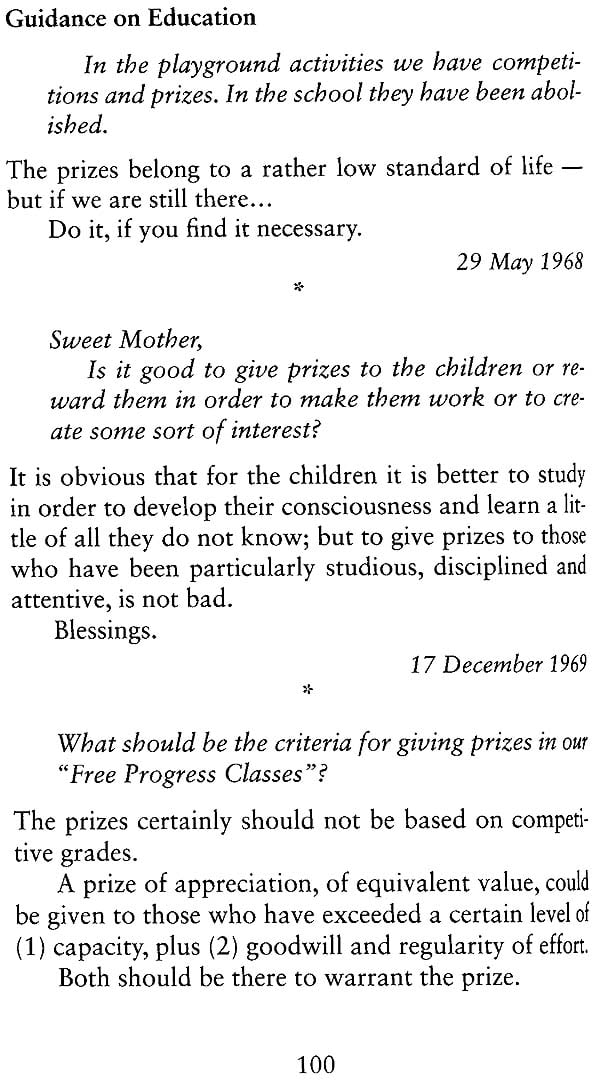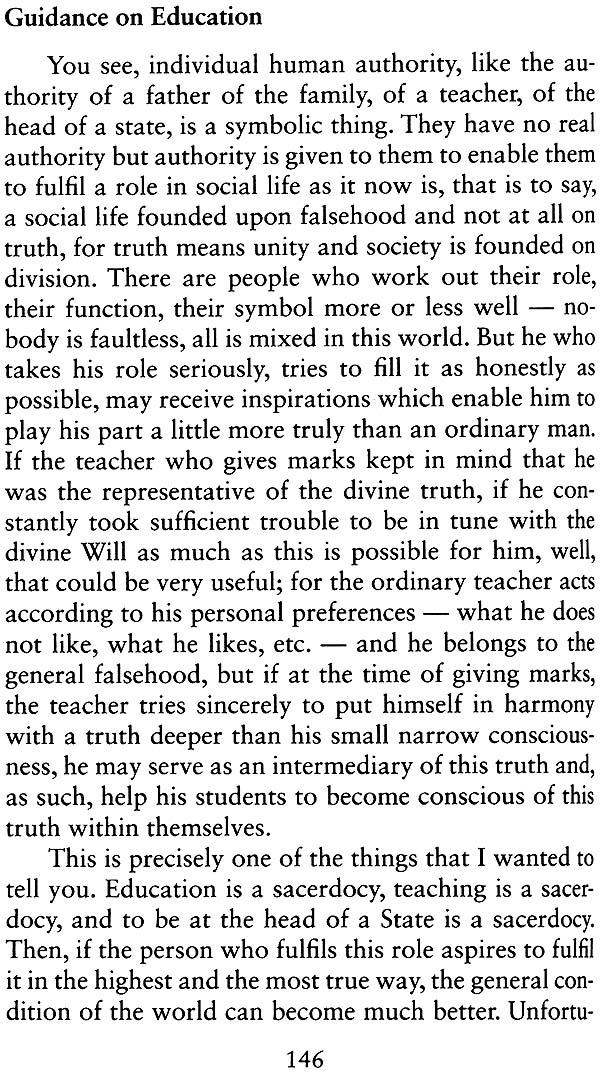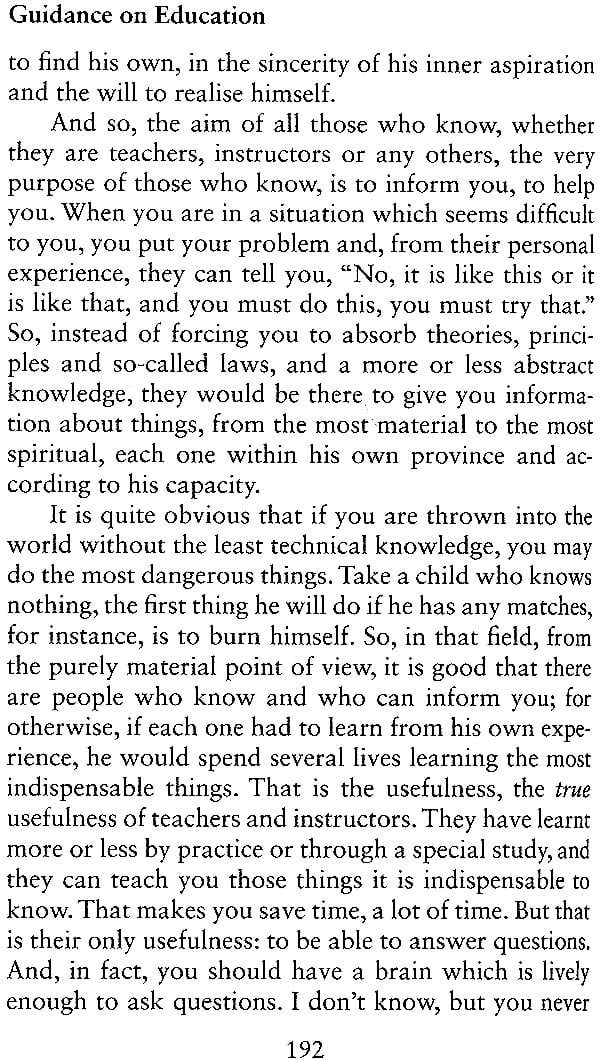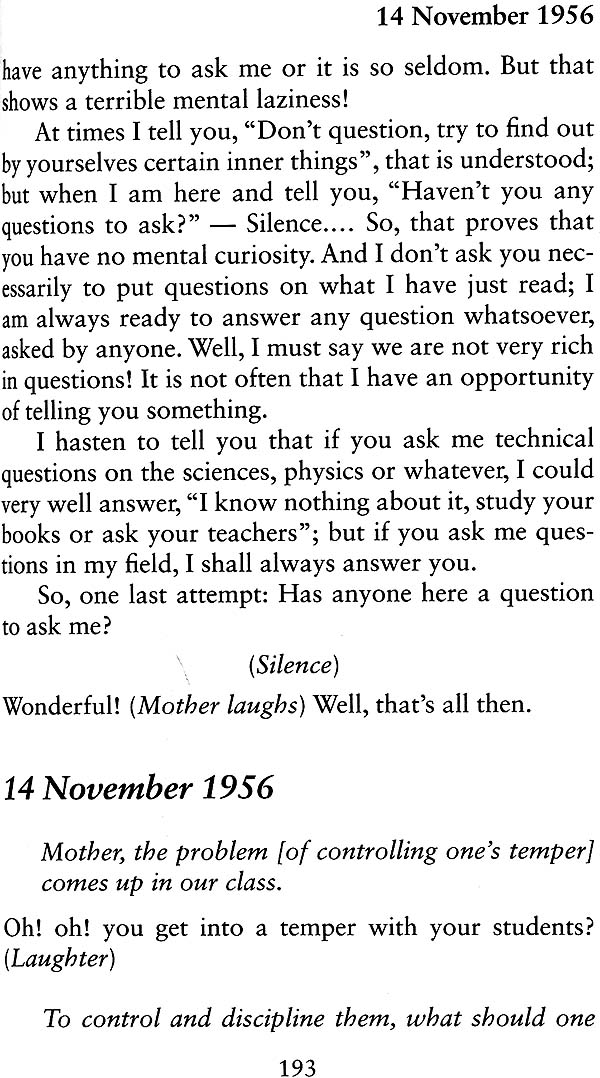
Guidance on Education - Advice to Students and Teachers
Book Specification
| Item Code: | NAN134 |
| Publisher: | Sri Aurobindo Ashram, Pondicherry |
| Language: | English |
| Edition: | 2015 |
| ISBN: | 9788170588894 |
| Pages: | 263 |
| Cover: | Paperback |
| Other Details | 7.5 inch x 4.0 inch |
| Weight | 250 gm |
Book Description
In December 1943 the Mother opened a school for the children who had come with their families to settle in the Ashram. The number of students steadily increased and the school eventually grew into the Sri Aurobindo International Centre of Education, with classes ranging from nursery to college level. The Mother asked some of the Ashram sadhaks to become teachers and offered her guidance to both students and teachers to create a centre of education whose aim was to develop all aspects of a student's personality. She wanted to provide an environment in which students could learn for the sake of knowledge, grow in consciousness and attain self-mastery, and prepare themselves for a higher and better life. This book, which was formerly titled Education (Part Two): Advice to Students and Teachers, contains selections from the Mother's correspondence and conversations. In them she reveals her keen understanding of how children learn and progress and encourages teachers to develop the powers of psychological understanding that will help them address the needs of each individual student.
This compilation consists mainly of selections from the Mother's correspondence and conversations with the students and teachers of the Sri Aurobindo Inter-national Centre of Education, the school of the Sri Aurobindo Ashram, Pondicherry. There are, in addition, a few notes and messages and some letters to young people living in the Ashram in the 1930s. Most aspects of education are discussed here, with the exception of physical education; the Mother's statements on that subject will be published in a separate book, as will her essays on education and oral commentaries on them.
This book is divided into two parts, the first consisting of written statements, the second, of conversations. A glossary of Sanskrit and other terms used in the text has been placed at the end of the book. We present below a brief history of the Mother's educational effort at the Ashram, culminating in the founding of the Centre of Education. This background should help the reader to better understand the statements in the book.
During the 1930s, the Mother's educational guidance in areas other than spiritual practice was limited to teaching French to a few people and offering general advice on other subjects. At that time there were only a handful of children living in the Ashram, a situation which changed in the early 1940s when several families were accepted. The children who came then were at first tutored informally, but in December 1943 the Mother officially opened a school for them. During the next few years the number of students steadily rose. Soon after Sri Aurobindo's passing in December 1950, the Mother announced her wish to establish a University Centre in his name. One year later, on 6 January 1952, she inaugurated the Sri Aurobindo International University Centre; this name was changed in 1959 to Sri Aurobindo International Centre of Education.
Classes at the Centre of Education range from nursery level to college level, with courses in the humanities, fine arts, sciences, engineering and vocational training. Mathematics and the sciences are generally taught in French, other subjects in English. Besides French and English, students often learn a simplified Sanskrit and their mother-tongue; some study other languages as well.
"It is not brilliant students that we want," said the Mother, "it is living souls." Thus the Centre of Education tries to develop all the aspects of the student's personality, and not only the mind. In addition to training the intellect through the sciences and humanities, there is an emphasis on cultivating the emotional and aesthetic faculties through the arts, and the body through physical exercise. As for spiritual growth, the Mother once observed that "this cannot be done by any external method"; therefore there are no prescribed courses or observances, though most of the older students study the writings of Sri Aurobindo and the Mother.
In its teaching method, the Centre of Education employs, as far as possible, what is called the free progress system. In this system the student is encouraged to assume responsibility for his own growth by choosing his own courses of study and pursuing them largely on his own. The teacher acts primarily as a guide rather than an instructor. In practice, the school's teaching system is a combination of the free progress system and the traditional method of direct instruction by the teacher. The Centre of Education does not hold formal examinations nor award degrees or diplomas because it seeks to awaken in its students a love of learning which is independent of utilitarian motives.
| Part I. Notes, Letters and Messages | 1 |
| Students | |
| The Aim | 3 |
| Youth | 8 |
| Study | 11 |
| Silence of Mind | 24 |
| Reading | 27 |
| Conduct | 32 |
| Holidays | 43 |
| Studies Elsewhere | 44 |
| Teachers | |
| Teaching | 48 |
| Discipline | 79 |
| Homework | 93 |
| Test, Promotions Prizes | 95 |
| Curriculum | |
| General Knowledge | 101 |
| Languages | 105 |
| The Arts | 112 |
| The Works of Sri Aurobindo and the Mother | 122 |
| National Education | |
| Message for the Inauguration of a French Institute in Pondicherry | 127 |
| Basic Issues of Indian Education | 129 |
| Part II. Conversations | 133 |
| Notes on the Texts | 250 |
| Glossary of Sanskrit and Othwer Terms | 251 |
